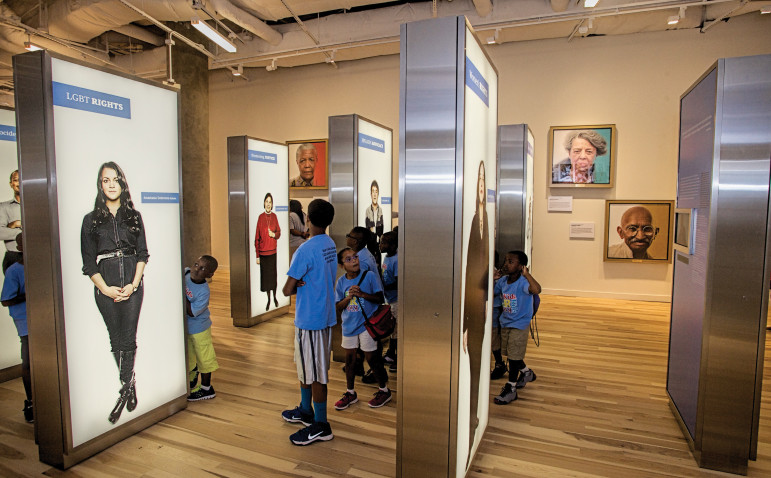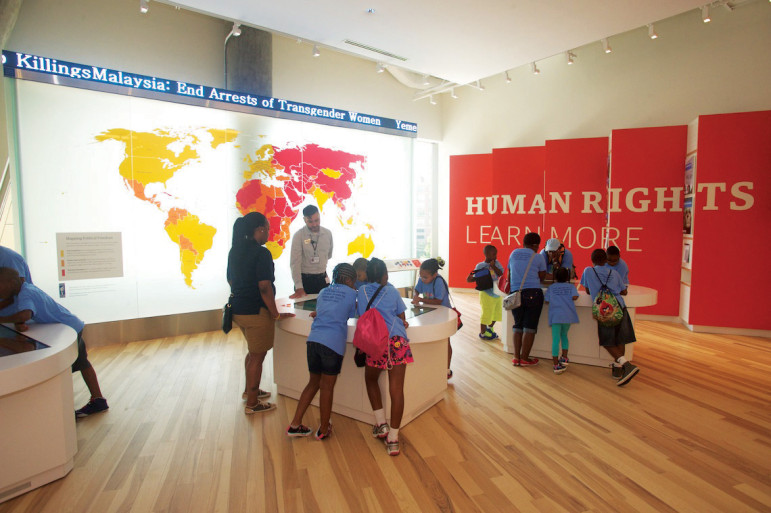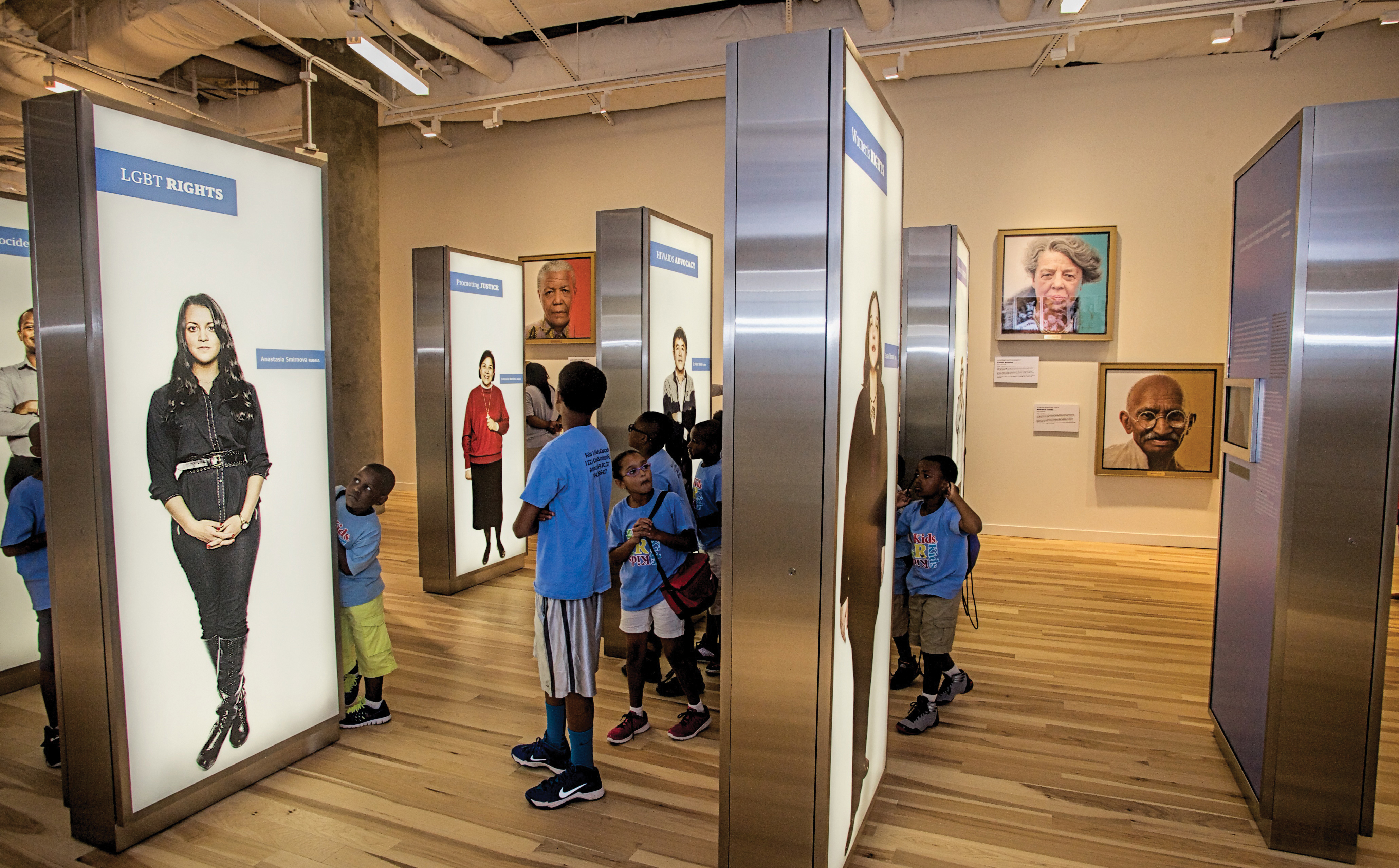
John Glenn
Students tour the LGBTQ display at the new National Center for Civil and Human Rights in Atlanta.
See sidebar “By the Numbers: Top LGBTQ Concerns Contrasted“
The children from Kids ‘R’ Kids of Cascade moved through the National Center for Civil and Human Rights in Atlanta as a group, wearing identical light blue T-shirts with the child care center’s phone number on back.
More than a dozen children ages 6 to 12 stood in front wide screens showing demonstrators marching and singing and being pummeled by water from high-pressure hoses. The children examined a replica of a lunch counter where black customers once were not allowed. They raised their eyes to a sign on the wall reading “WHITES ONLY beyond this door.”
Then, all together, the group ascended the stairs to the next exhibit, where the life-size image of a gay activist looks out from a mirrored panel among other activists.
This center, which opened June 23, packs a punch, with music, archival TV footage, beautiful visual and interactive displays of the civil rights struggle in the South.
It sends a distinct message to visitors to take up the cause of human rights, including gay rights.
Because it presents a wealth of information about freedom struggles to a new generation, it’s a valuable resource for youth and youth leaders.
It links the struggle for African American civil rights to human rights struggles around the globe.
Seeing injustice up close
Inside the center one day this summer, a young girl turned from a large image of the 9- or 10-year-old Emmett Till and his mother smiling out of their studio portrait. “Who’s that?” she asked her mother.
He was killed in Mississippi when he was 14, her mother replies. “Why?” the child asked.
In another room, the Kids ‘R’ Kids campers sat in a semicircle on the floor.
“These girls were your age,” said tour guide Gabriel Wardell as he pointed to four faces in stained glass above a dark hearth of rubble representing the 16th Street Baptist Church in Birmingham, Ala., which was bombed in 1963.
The children were quiet and their eyes were wide. Later they recalled that room as one of the most memorable parts of the museum.
Upstairs in the section devoted to global human rights, visitors first see a wall of vertical mirrors. On the surface of the mirrors, life-size images of people fade into view. Words describing them — Muslim, Christian, immigrant, refugee, gay — are scattered across the mirrors. Visitors push a button to hear the voice of each person.
Damaris Rostran comes into view. Her voice speaks about being persecuted for being gay.
“You can’t say ‘I am a lesbian’ in Nicaragua,” she said. If you do, you put yourself in danger. Rostran was beaten and her friend was murdered.
In the next room, a life-size image of Anastasia Smirnova stands among images of other activists. Her recorded voice talks about how authorities in Russia intimidate and detain people who speak out for gay rights.
A nearby exhibit explains the Universal Declaration of Human Rights in words even young kids can understand.
“Human rights apply to everyone: your mom, your dad and you.”
What are human rights? “They are the choices we make everyday as human beings.”
It goes on to ask: “Who will make them a reality?”

John Glenn
The Civil Rights Museum in Atlanta features a map visually depicting human rights violations by country.
How youth-serving organizations respond
“It’s a civil rights and human rights issue for sure,” said Ellen Kahn, speaking of the way lesbian, gay, bisexual and transgender (LGBTQ) people are treated. Kahn is director of the Children, Youth & Families Program for the Human Rights Campaign Foundation.
Just as some youth organizations once rejected African-American children, they have a range of responses toward LBGTQ rights.
Some are actively creating welcoming spaces for LGBTQ kids. Others express an open-door policy for LGBTQ youth but may not have thought about the specifics. Some may be grappling with their position on the issues, while others believe it is wrong to support lesbian, gay or transgender youth and do not welcome them.
Girl Scouts of the USA is an organization with a clearly stated policy that it does not discriminate on any basis, “including race, ethnicity, sexual orientation, or gender identity.” The national organization intervened in 2011 when a 7-year-old transgender girl was initially denied membership in a Colorado troop. It reached out to the family and the child and issued a statement that it was accelerating its support systems and training on the issue.
Many organizations feel they need to do more to be welcoming, and a number are quietly getting advice from the Human Rights Campaign. They are not making public statements about it, possibly to avoid the criticism the Girl Scouts took for their stand.
“I think a lot of them have learned from the Boy Scouts,” Kahn said. The Boy Scouts went as far as the Supreme Court in 2000 to uphold its ban against gay members. The organization became a battleground in 2012 over the issue. It eventually changed its policy to allow gay boys while keeping a ban on gay leaders.
Some groups, however, “see themselves as welcoming all youth, but in reality it’s not really happening,” Kahn said. Kids may be bullied, verbally harassed, mocked and marginalized.
In other programs, diversity and inclusivity are not even a stated priority.
Sometimes they say, “We don’t have any gay kids here and we haven’t had incidences of bullying,” Kahn said.
Group leaders may not know because kids aren’t talking. When kids don’t feel that it’s safe to be openly gay, they don’t reveal themselves, Kahn said. She tells groups about the impact on a kid’s mental health.
Bullying and harassment
LGBTQ kids, for example, experience a high level of bullying and harassment. According to the 2011 National School Climate Survey, 82 percent had been harassed in high school or middle school because of their sexual orientation, and 63 percent felt unsafe. The survey was released by GLSEN, the Gay, Lesbian and Straight Education Network.
The survey reported that 38 percent had been pushed or shoved because of their sexual orientation and 18 percent had been physically assaulted (punched, kicked or injured with a weapon) because they were gay or lesbian.
Among transgender students, 80 percent said they felt unsafe.
LGBTQ youth are also at increased risk for suicide. A report in the American Journal of Public Health in 2001 found suicide attempts to be twice as likely among lesbian, gay and bisexual youth. A 2010 report in the Annual Review of Public Health found that the stresses experienced by LGBTQ youth led to a higher risk for mental health problems, substance use and physical health problems. Among some organizations, including sports teams, a mindset exists among parents, coaches, other youth leaders and kids that LGBTQ kids are undesirable. Name-calling and harassment can go on with no intervention, Kahn said. Unspoken assumptions create a toxic climate.
Further along on the spectrum are groups that have an active policy against rights for LGBTQ people. They tend to base their beliefs on religion, Kahn said.
“There are still a lot of people who believe being gay is a sin against religion,” she said. They believe sexual orientation can be changed or they say you shouldn’t act upon it, she said.
“If you hold that belief, you don’t make the leap to human rights,” she said.
These groups, however, represent a minority of youth organizations, she said.
The goal of helping kids
What unites youth-serving organizations is their mission to serve and protect young people. At minimum, they can get behind efforts to prevent bullying.
To those who would shun young gay people Kahn says: You still have a mission to help youth learn how to negotiate an increasingly complex world, which includes people with diverse sexual orientations and gender identities. All youth organizations need to provide messages that strengthen young people, she said.
Kahn goes a step further. If an organization doesn’t want to work with LGBTQ youth, they should make it clear, she said. Kids will at least be able to steer away from programs that ultimately give them a message of shame.
The Center for Civil and Human Rights demonstrates well the virulence of the racism that has existed in the United States — particularly in the South — and shows the courage of those who fought against it.
As it connects the civil rights movement to other struggles, its message against racism is not diluted.
The child who didn’t know about Emmett Till’s murder may not know about Matthew Shepard’s either.
The museum issues a call to action. From this follows the message that youth leaders have a responsibility to recognize injustice, answer young people’s questions about injustice — and rectify it.
See sidebar “By the Numbers: Top LGBTQ Concerns Contrasted“




























